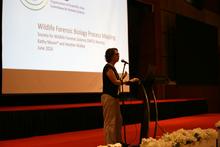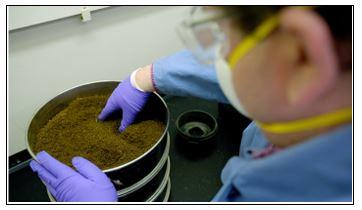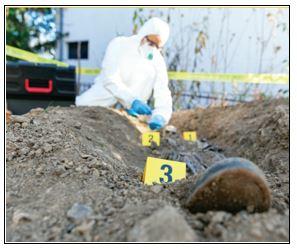August 2024
This Standards Bulletin from the Organization of Scientific Area Committees (OSAC) for Forensic Science provides a monthly update on forensic science standards moving through the OSAC Registry and standards development process, along with other OSAC news and standards-related information.
THE OSAC REGISTRY IMPLEMENTATION OPEN ENROLLMENT EVENT IS HAPPENING NOW! BE SURE TO CHECK OUT THE “IMPLEMENTATION IMPACTS & RESOURCES” SECTION BELOW!
STANDARDS UPDATES
OSAC Registry Updates
As of August 6, 2024, the OSAC Registry contains 199 standards (137 published and 62 OSAC

Proposed) representing over 20 forensic science disciplines.
The following standard has been updated on the OSAC Registry. Note: This update includes an editorial change only and no changes in content have been made.
Standards Open for Comment
SDO Published Standards Under Consideration for the OSAC Registry
The OSAC Registry approval process for published standards is used to review existing SDO published standards for technical quality and placement on the Registry. Please submit your comments by 11:59 p.m. ET on September 2, 2024, on whether the following SDO published standards should be included on the Registry:
- ANSI/ASB Standard 035, Standard for the Examination of Documents for Alterations. 2020. 1st Ed. Submit your comments here.
- ANSI/ASB Standard 147, Standard for Analyzing Skeletal Trauma in Forensic Anthropology. 2024. 1st Ed. Submit your comments here.
OSAC Proposed Standards Under Consideration for the OSAC Registry
- There are no OSAC Proposed Standards currently being considered for the OSAC Registry at this time.
Standards Open for Comment at Standards Development Organizations (SDOs)
There are 29 forensic science standards currently open for public comment at:
- Academy Standards Board (ASB)
- Biology/DNA (1) with a public comment deadline of September 9.
- Bloodstain Pattern Analysis (1) with a public comment deadline of August 19.
- Crime Scene Investigation & Reconstruction (1) with a public comment deadline of September 16.
- Firearms & Toolmarks has (1) with a public comment deadline of August 19 and (1) with a public comment deadline of September 9.
- Footwear & Tire (1) with a public comment deadline of September 2.
- Forensic Odontology (1) with a public comment deadline of September 9.
- Forensic Toxicology (2) with a public comment deadline of August 19 and (1) with a public comment deadline of September 2.
- Friction Ridge (1) with a public comment deadline of August 26.
- ASTM
- Facial and Iris Identification (2), Ignitable Liquid Explosives & Gunshot Residue (4), Trace Materials (2), Video/Imaging Analysis Technology & Analysis (2) standards with a public comment deadline of September 16.
- Scientific Working Group on Digital Evidence (SWGDE). Ten documents with a deadline of September 15.
Visit OSAC’s Standards Open for Comment webpage to access these documents and for the instructions on how to submit your comments.
SDO Updates
New Published Standards
From ASB:
- ANSI/ASB Standard 148, Standard for Personal Identification in Forensic Anthropology. 2024. 1st. Ed. (new standard)
- ANSI/ASB Standard 175, Standard for Interpreting and Reporting DNA Test Results Associated with Failed Controls and Contamination Events. 2024. 1st. Ed. (new standard)
- NOTE: This is the SDO published version of OSAC 2020-S-0004, currently on the OSAC Registry.
From ASTM:
- ANSI/ASTM E1459-24, Standard Practice for Physical Evidence Labeling and Related Documentation (revision)
Work Proposals for New or Revised Standards
On August 2, 2024, a Project Initiation Notification System (PINS) was published on pages 2-3 in the ANSI Standards Action. This will begin ASB’s work on the following standard:
- BSR/ASB Best Practice Recommendation 213-202x, Family Engagement Following a Mass Fatality Incident: Victim Information Center Best Practice Recommendations for Medicolegal Death Investigation Authorities (new standard). This document provides the best practices included in establishing a Victim Information Center as quickly as possible following a disaster incident to offer a location where the medicolegal death investigation authority and law enforcement can collect forensic reference samples and antemortem data. Practitioners are expected to use this document to develop, implement, exercise, and review mass fatality plans and updating existing procedures to optimize forensic data collection.
- NOTE: This OSAC Proposed Standard, OSAC 2022-N-0021, is currently on the OSAC Registry.
Projects Withdrawn
- ASB Best Practice Recommendation 012-202x, Best Practice Recommendation for Articulating a Source Identification in Friction Ridge Examinations. Based on feedback received from commenters and ASB Consensus Body members, this document was discontinued as a Best Practice Recommendation and will be reformulated as a Technical Report.
IMPLEMENTATION IMPACTS & RESOURCES
Open Enrollment is Off to the Races!

The 2024 Open Enrollment Season officially started on Monday, July 8, and will conclude September 2.
As of the date of this publishing, the OSAC Program Office (OPO) has received 26 survey submissions, (16 new FSSP locations, and 10 updated survey submissions)! Thank you to all who have submitted responses!
Nationally, 176 FSSP locations have informed OSAC that they have implemented standards on the OSAC Registry. Help us reach our GOAL OF 200 FSSPs BY THE END OF THE OPEN ENROLLMENT SEASON ON SEPTEMBER 2.
Submit a survey with the new and easy-to-use online tool. Don’t get left in the dust!
Do you have questions about implementation or need your assigned OSAC ID? Email forensics [at] nist.gov (forensics[at]nist[dot]gov) or refer to the survey User Instructions.
Qualtrics Survey Beta Testers
OPO would like to recognize and extend a HUMONGOUS and ever grateful THANK YOU to the following people who dedicated their free time to assist with beta testing the new online OSAC Registry Implementation Survey:

Laura Bryant, Massachusetts State Police Crime Laboratory
Steve Johnson, OSAC Standards Ambassador
Eva King, Wisconsin State Crime Laboratories
Kim Kunkler, Marshall University
Jennifer Limoges, New York State Police Laboratory
Delilah Ortiz-Meyer, United States Army Criminal Investigation Laboratory (USACIL)
Karen Reczek, NIST Standards Coordination Office
OSAC NEWS
Next OSAC FSSB Public Feedback Session is September 10

The OSAC Forensic Science Standards Board (FSSB) will have a public feedback session available during its upcoming quarterly meeting on Tuesday, September 10, 2024, from 1:30 - 2:00 p.m. ET. The purpose of this public session is to provide stakeholders with an opportunity to share feedback with the FSSB related to agenda items or matters within the FSSB’s authority. The FSSB will consider all feedback from the public, and remarks can be made by the submitter or by the OSAC Program Office on behalf of the submitter.
If you wish to share feedback with the FSSB, please complete this form by Monday, September 2, 2024.
The schedules and agendas for upcoming FSSB meetings can be found on the FSSB Meetings webpage.
Last Call for Nominations: 2024 Sharon B. Nakich Award
OSAC is seeking nominations for the 2024 Sharon B. Nakich Award. As of the date of this publishing, OPO has not received any nominations for this award.
In honor of our colleague, Sharon Nakich, this OSAC peer-to-peer award acknowledges a helpful attitude, kindness, teamwork, or behind-the-scenes contributions to support the goals of OSAC. It recognizes an individual who has made significant contributions to promote OSAC’s mission through their support of OSAC. This nominee works diligently and tirelessly as a champion for OSAC, at times without recognition.
Eligibility:

- All OSAC members and affiliates
- Any non-OSAC member who has contributed significantly to furthering the mission of OSAC
To submit your nomination, please provide two or more narrative statements from two or more different individuals addressing the criteria mentioned above. Nomination justifications should include, but are not limited to, a description of:
- Specific activities the nominee was involved in that had a positive effect in supporting OSAC’s mission,
- How the individual’s action helped the organization further its goals
- Describe the nominee’s willingness to go the extra mile.
Please send your nomination and supporting documentation to crystal.degrange [at] nist.gov (Crystal DeGrange) by Friday, August 24, 2024.
OSAC Referenced in the Association of Firearm and Toolmark Examiners (AFTE) Journal

The AFTE Journal of the Association of Firearm and ToolMark Examiners recently published the article “Trigger Pull Variability and Its Uncertainty of Measurement.” This article, authored by Holli L. Worden, a Bexar County, Texas, Criminal Investigator, talks through the importance of measuring the trigger pull force during shooting investigations. She discovered that measurements taken from the central location of the trigger (the most common location used by an index finger) differed significantly in comparison to measurements taken from the tip of the trigger (often occurring in accidental shootings). The article repeatedly refers to the OSAC generated and ASB published Best Practice Recommendation 107, Measuring Trigger Pull of a Firearm and Estimating Its Uncertainty as a framework for how the trigger pull measurements were made and how the uncertainties were calculated. As a basis for the use of this document, the author references Section 7.2.1.4 of ISO/IEC 17025: 2017 which recommends using methods published, “by reputable technical organizations, or in relevant scientific texts or journals.” That’s us!
If you have access to the AFTE Journal, check it out on page 7, and share with other firearm investigators!
🌟 Congratulations Firearms and Toolmarks Subcommittee! 🌟
Worden, Holli L. (2024). Trigger pull variability and its uncertainty of measurement. Association of Firearms and ToolMarks Examiners Journal, Vol. 56(1), 7-27.
In Memoriam

Dr. Stephen L. Morgan, age 75, an indispensable contributor to forensic science, sadly left our world on July 2, 2024, after a life richly lived in kindness and service to others. Among his many significant accomplishments in his field, he served as the statistician on the Chemistry/Instrumental Analysis SAC from 2014 to 2019 and assisted the Forensic Toxicology SC with several documents. His remarkable expertise (see 140+ page Curriculum Vitae) was critical to OSAC and to the world of forensic science.
You may leave a note in the digital guestbook for his family.
OSAC OUT & ABOUT
Society for Wildlife Forensic Science Meeting

OSAC’s Wildlife Forensic Biology Affiliate, Kathy Moore, and colleague Heather Waltke attended the Society for Wildlife Forensic Meeting June 24-28, in Kuala Lumpur, Malaysia. Their presentation was based on the draft Wildlife Forensic Process Map: "How did we get from submission to results? Process mapping in Wildlife Forensics." There were 123 registrants representing 30 countries in attendance.
Database Development Workshop
Kathy also facilitated a Database Development Workshop, where she worked through an exercise to taxonomically identify "unknown" sequences using the OSAC generated and newly published standard: ANSI/ASB 180, Standard for the Selection and Evaluation of GenBank® Results for Taxonomic Assignment of Wildlife.
Revisiting the Wildlife Forensic GenBank Interlaboratory Study
In 2023, an interlaboratory study was conducted to assess the practical utility of OSAC 2021-S-0006, Standard for the Use of GenBank for Taxonomic Assignment of Wildlife.
The full article was published December 2023 and is now available for free via an open-access reprint: “Interlaboratory study to assess the practical utility of OSAC proposed standard 2021-S-0006: Standard for the use of GenBank for taxonomic assignment of wildlife.”
Scientific Working Group on DNA Analysis Methods (SWGDAM) Meeting

Carl Sobieralski, Biology/DNA SAC Chair, attended the SWGDAM meeting July 8-11, 2024 as a liaison for OSAC. Carl observed and participated in the discussions for each of the subcommittees working on projects to help the forensic DNA community. A lot of valuable information was gained on the projects SWGDAM is working on for guidance and standardization in the forensic community. This information is valuable to help the Biology/DNA SAC understand what is currently being worked on by SWGDAM. The Biology SAC intends to collaborate with SWGDAM on future standardization efforts.
UPCOMING EVENTS
- August 12-16: International Association for Identification Annual Conference (IAI) | Reno, NV. Check out these NIST, OSAC and other standards-related presentations happening at the IAI Conference!
- August 27-29: 2024 International Conference on Forensic Nursing Science and Practice | Denver, CO
- September 4: OSAC Leadership Strategy Session | Virtual
- September 8-13: Midwestern Association of Forensic Science (MAFS) | Kansas City, MO
- September 9-10: FSSB fall quarterly meeting | Research Triangle Park, NC
- September 16-19: Scientific Working Group on Digital Evidence (SWGDE) Meeting |Houston, TX
- September 19-23: National Association of Medical Examiners (NAME) Annual Meeting |Denver, CO
- September 23-26: International Symposium on Human Identification (ISHI) Meeting |San Antonio, TX
- October 1-4: 23rd Annual Association of Quality Assurance Managers (AFQAM) Conference | Daytona Beach, FL
- October 19-22: International Association of Chief of Police (IACP) Annual Conference and Exposition | Boston, MA
OTHER FORENSIC SCIENCE NEWS & TRAINING
NIST’s New Hemp Reference Material

The National Institute of Standards and Technology (NIST) is now selling hemp reference material that will help laboratories accurately measure key components in cannabis plant products. Read the article to learn how law enforcement agencies can accurately distinguish between hemp and marijuana with NIST’s new reference material.
ASTM To Publish a New Standard to Improve Automated Facial Recognition Search Performance

ASTM International’s Forensic Sciences Committee (E30) has approved a new standard that will help to improve automated facial recognition search performance. The new standard (soon to be published as E3445) will help to improve search results for people using a facial recognition system (FRS). In this ASTM Standardization News article, hear from Lora Sims, ASTM member and Chair of OSAC’s Digital/Multimedia Scientific Area Committee as she talks about the importance of this document. Once published, this standard will be evaluated for placement on the OSAC Registry.
NEW! Death Investigation Guide Now Available
The National Institute of Justice (NIJ) and its partners have released an updated technical guide for conducting collaborative death scene investigations.

Death Investigation: A Guide for the Scene Investigator, 2024
The 2024 guide accounts for key changes in the field, including:
- Advances in DNA technology, communication and documentation technology.
- Procedures for drug, child, and infant death investigations.
- Collaboration between investigators and professional partners, families, and the media.
AAFS Consensus Body Members Needed
The AAFS is announcing new membership opportunities for existing consensus bodies:
Anthropology
Biology/DNA
Bloodstain Pattern Analysis
Crime Scene Investigation
Dogs & Sensors
Firearms & Toolmark
Footwear & Tire
Forensic Document Examination
Forensic Nursing
Forensic Odontology
Friction Ridge
Mass Fatality Management & Disaster Victim Identification
Medicolegal Death Investigation
Toxicology
Wildlife Forensics

An on-line application form and links to several relevant documents describing the American Standards Board (ASB) is available on the AAFS website. Applicants are requested to submit the online form to be considered for serving on the ASB consensus bodies by August 12, 2024.
Please contact Teresa Ambrosius, for questions at TAmbrosius [at] aafs.org (TAmbrosius[at]aafs[dot]org).
AAFS Standards Resources and Training
As part of a cooperative agreement with NIST, the American Academy of Forensic Sciences (AAFS) is developing training, tools, and resources to enhance implementation efforts and broaden awareness of forensic science standards among communities of interest.
- Standards factsheets provide a clear, concise, and easy way to understand the purpose of a specific standard, why it is needed, and the benefits of adoption. Standards factsheets are available for 135+ standards on the OSAC Registry.
- Standards checklists are a tool that forensic science service providers can use to track progress towards implementation, identify gaps or barriers to implementation, or document objective evidence of implementation or compliance with a standard. Checklists are available for 130+ standards on the OSAC Registry.
- Standards videos and webinars are available for free from AAFS Connect. Learn about the standards development process, standards development activities in various disciplines, and information about specific SDO published standards on the OSAC Registry.
CONNECT WITH OSAC
Follow us on Social Media
To stay up to date on the latest OSAC news, be sure to follow us on LinkedIn (#ForensicOSAC).
Contact Us. If you have feedback, questions, or want to learn more about how you can help strengthen forensic science through standards, contact us at forensics [at] nist.gov (forensics[at]nist[dot]gov).


